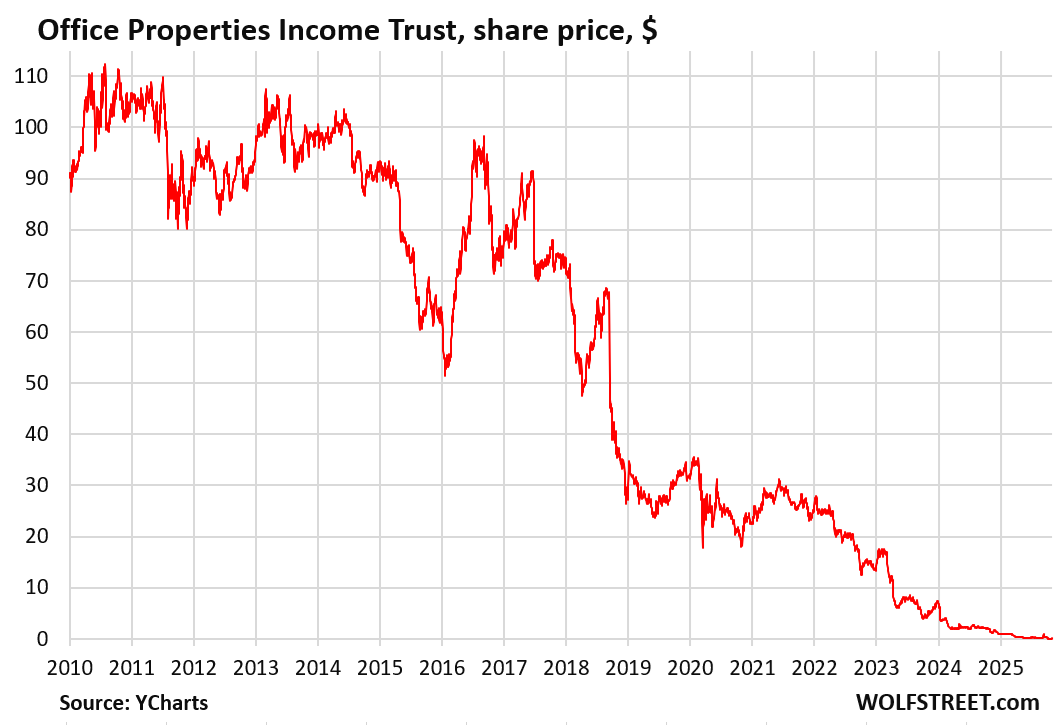Shareholders got wiped out, noteholders take losses and get the company, banks appear to be largely unscathed.
By Wolf Richter for WOLF STREET.
Here is an example of who is taking the losses from the office meltdown in commercial real estate: Office Properties Income Trust, a publicly traded office REIT that owns 122 office properties with a combined 17.1 million in rentable square feet of office space, filed for Chapter 11 bankruptcy on Thursday – the first office REIT to file for bankruptcy.
The US government is the largest tenant at its properties. The occupancy rate across all properties has dropped to 77%, according to the company’s Business Plan released in August.
The properties themselves are managed by a property management company, The RMR Group. Office Properties Income Trust is just the owner.
So who took the losses?
Stockholders first: And that started years ago. In 2017, market capitalization of the REIT was nearly $2 billion. After the total collapse of the shares since then, market cap is now essentially zero, with the delisted shares trading Over the Counter for 2 cents, down from over $110 in 2010.
So over the past 8 years, $2 billion of the losses were taken by stockholders collectively – a near 100% loss that could become a total loss, as the company warned in its SEC filing about the bankruptcy: “The Company expects that holders of Company’s common shares of beneficial interest could experience a significant or complete loss on their investment, depending on the outcome of the Chapter 11 Cases.”

The REIT listed $2.42 billion in debt in its bankruptcy disclosure with the SEC, not including unpaid interest. This debt is composed of: Two mortgage loans totaling $177 million (UBS and JPM), secured by specific properties; and eight note issues totaling $2.24 billion, some secured, others unsecured.
The noteholders. Of this $2.24 billion in bonds, $280 million mature in 2026. But as of June 30, the company had only $78 million in unrestricted cash and $14 million in restricted cash. In Q2, it booked a net loss of $87 million. Losses in Q3 likely ate further up the cash cushion, and out of cash, the company filed for bankruptcy.
When OPI filed for bankruptcy, it also entered into a restructuring agreement with holders of its secured notes – so a pre-packaged bankruptcy filing. The agreement, which still needs to be approved by the bankruptcy court, calls noteholders to give up $1.1 billion collectively, in exchange for equity in the restructured company.
This agreement would reduce OPI’s outstanding debt from $2.4 billion currently, to $1.3 billion upon exit from bankruptcy. The new owners will mostly be the noteholders that received equity in exchange for the debt.
How much the debt holders will collectively lose depends on the outcome of the bankruptcy proceedings and the ultimate value of the equity in the restructured company that they will receive in exchange for the debt.
The banks: The filing listed a $54-million mortgage from UBS and a $123-million mortgage from JPM. It appears, the banks won’t have to endure a haircut or have to take the office buildings back as part of the bankruptcy, though the mortgages may be amended or restructured.
In case you missed it:
Enjoy reading WOLF STREET and want to support it? You can donate. I appreciate it immensely. Click on the mug to find out how:
![]()


Stonecutters:
Who controls the British crown?
Who keeps the metric system down?
We do, we do!
Carl: Who leaves Atlantis off the maps?
Lenny: Who keeps the Martians under wraps?
We do, we do!
Who holds back the electric car?
Who makes Steve Guttenberg a star?
We do, we do!
Seymour Skinner: Who robs cave-fish of their sight?
Homer: Who rigs every Oscar night?
We do!
We do!
The Simpsons Take the Bowl
Who controls the British crown?
Who keeps the metric system down?
We do, we do!
Who keeps Atlantis off the maps?
Who keeps the Martians under wraps?
We do, we do!
Who holds back the electric car?
Who makes Steve Guttenberg a star?
We do, we do!
Who robs cave-fish of their sight?
Who rigs every Oscar night?
We do, we do!
Who gives their song an extra verse?
With no time to rehearse?
We do!
We do!
Average occupancy 77% and still you go under?
I would have thought that could keep ship afloat/give time to cut the real loss buildings and turn into build-able lots what have you.
I guess the purchase prices were way too high/just mismanaged.
It’s not the occupancy rate that pushed them into bankruptcy (though 77% doesn’t help). It’s the bonds that come due in 2026, and the company is out of money and cannot borrow more and cannot pay off those bonds and cannot afford to pay the current interest rates that deep-junk-rated bonds come with. There is no way around this without a debt restructuring.
RMR group should be fired. As the article points out they ran the reit into the ground since 2017. Look at the stock price chart. They are grossly incompetent. OR?? RMR and their restructuring partner, the Ad Hoc Group of the September 2029 Notes are the primary beneficiaries of this bankruptcy at the expense of the common shareholders, the unsecured bond holders and other creditors. I believe the owners of OPI, the common shareholders, can simply rescind the management agreement with RMR in the bankrupcy court. They should fiire RMR, appoint a receiver and convert the chapter eleven to a liquidation. But the common holders must get a seat at the table to effect the firing of RMR as the manager and pushing a total or partial liquidation. To date they have no representation in the bankruptcy proceeding.
I have over 40 years experience in leasing, selling and managing High Rise office buildings. Albeit an optimistic scenario I believe a sale of all the properties less a 5% cost of sale (which is excessive for these types of properties but the receiver and bankruptcy cost need to be accounted for) would pay off all debt holders secured and unsecured and leave $1 to $3 per share for the commons. Even a partial liquidation during the chapter eleven will bring in enough capital to keep the company whole and prevent the common shareholders from losing 100%. The squeeze right now is the up coming Capex over the next 2 years and principal payments on the 2027 Senior secured notes. OPI has some premium properties with long term high credit tenants it could sell. They haven’t made legitimate efforts to sell properties. They also have vacant properties they could sell at, yes “fire sale prices” becuase they are bleeding”. Negative NOI. If they just give them away it will increase cash basis NOI by the losses they are now showing. But they don’t need to give them away. Sell them for $40, $50 or more per square foot. Do it now. Begin the process of firing RMR.
Insightful comment! Office sales in 2024 and 2025 have come with haircuts of 40% to 70% and higher from pre-covid prices, depending on market and property. There is now a decent deal flow, but with these kinds of haircuts from pre-covid prices. Blackstone just sold a portfolio with these kinds of haircuts. So it would be interesting to see if a liquidation would leave anything for the unit holders.
Yes, there is a way around this instead of a restructure; liquidation.
The number one beneficiary of restructuring is RMR. The entity who managed the company to its current state. They will receive “management fees” of $14 to $28 million as a third party “manager” plus property management fees for the actual management of the properties. For what? Look at their past performance? Look at the performance of the other REITs they “manage” as well.
There are only partial bond payments due in 2026. Partial principal payments of $6.5 million are due quarterly and $120 million on due March 1, 2026 on the $445 million bonds due 2027. (principal payments have already been made and the current balance $418 million). The restructuring plan as currently proposed liquidates these bonds by in essence Liquidating the properties securing these bonds. The restructuring plan states the holders of these bonds will receive the properties, cash or take back debt or combination of these. So these bonds will receive 100 cents on the dollar in a liquidation. Giving properties and cash to a creditor is a liquidation.
Why that solution for those bond holders? Because the holders of those bonds have objected to the “restructure”. Why not a liquidation for all creditors. All secured creditors will receive 100 cents on the dollar in a liquidation. And there will be cash left over; cash to pay the unsecured debt holders. Oh, but RMR would receive nothing.
My contention is if the REIT was liquidated rather than restructured the unsecured bond holders would likely receive 100 cents on the dollar. And I believe there would likely be money left over for the commons. But clearly in a liquidation the unsecured bond holders would receive more than the 10 to 15 cents on the dollar they are currently trading at in the market and may receive (I stress may receive, if anything) through the restructure.
So liquidation is beneficial for all parties except RMR.
Bad CRE is something the Federal Reserve should own; perhaps by trading MBS that has equity for the worthless CRE at face value. That would be a win-win in the losses being socialized while the MBS loss is never realized.
Sarcasm, I think?
Excuse me Gary, but I would very much appreciate my tax dollars to not be spent bailing out CRE bag holders based on their poor investment performance. I really hope your comment is sarcastic. Otherwise, you might get an earful from Depth Charge (I’d relish that).
The Fed prints it’s own money; it doesn’t use your tax dollars. If they owned this on their balance sheet, they could cancel it and their “assets” would be less, a graph Wolf has shown many times. (Note: I agree that the original comment is just sarcasm.)
Well printed money is sort of a tax as it dilutes the value of your purchasing power at a faster rate than anything else.
Let’s get him, boys!
You want to own commercial properties?
-stay away from banks
-stay away from mortgage on property
-stay away from property management (they are clueless anyway)
-do maintenance yourself
-own the property free and clear
-make the tenants happy
And you’ll make mucho dinero…easy 10% NOI…
Two questions.
How do you accumulate the cash to buy f&c?
Is it a full-time job to manage and do maint?
1.I happened to accumulate the necessary cash after 32 years of working my butt out in different industries including construction…
2. Maintenance is determined by building repair need…I happened to remodel it from top down, including new parking lot, new roof, new electrical panel etc…
Due to my experience, maintenance is a walk in the park…
PS. Depending where you live, commercial building maintenance is prohibiting expensive…just to adjust a front door the guy wanted $2,200 …I’ve told him to get lost…
@truthseeking congratulations of you are getting a 10% NOI (aka ROE if you don’t have any debt) but few people (even those that do ALL the management and maintenance themselves) have seen a 10% cap for decades. Are you getting a 10% return on the “current” market value of your peoperty (you use “current” market value to calculate NOI not “purchase price”),
And have bought the building many years ago
So was the property management company and its management fees the way the monies got funneled to the right people instead of the bagholders? Or how does it work?
Yes. The question is whether the compensation was commensurate with the service provided or inflated to line their pockets? Eye of the beholder and all that.
How can the bank note holders be “largely unscathed” if they have to exchange debt for common stock in a bankrupt company?
As the article points out, the two banks hold mortgages (not notes) secured by specific properties, and the REIT is going to keep those properties and maintain the mortgages.
It is not just occupancy percentage, it’s also amount of the rents, which may have been declining to maintain the occupancy they have, and the prices paid by the REIT to acquire the properties, and the fees and commissions paid to set up and maintain the Reit.
Don’t forget that local governments will lose on property taxes, since the buildings’ valuations must also go down (if they haven’t already).
I’m not familiar with how valuations work in real estate like this, but shouldn’t the asset price be the same even if it gets sold at a discount? Isn’t residential appraised every now and then so property tax doesn’t get pegged to the price you paid two decades ago?
Yes, that is a huge issue for local governments. These central business districts are massive tax generators for local governments, such as here in San Francisco, and landlords have pushed for a 50% reduction in assessed value of those office properties.
This financial disaster reminds me of the huge losses sustained by REIT shareholders around 1974 or 1975.
The involvement of big banks certainly brings back the whiff of 2007. I’m sure these billions are a drop in the bucket, but wasn’t it Jamie Dimon who was warning us about “cockroaches” just a couple of weeks ago? I’m sure he had this roach in mind.
Even more concerning is the question of how much of the US’s money supply is created by shadow banks which are not held up to the scrutiny regulated banks like JPM face. Why should anyone believe they – with minimal regulation – had higher lending standards than all the banks which bought residential mortgages in the oughts, or apparently JPM a few years ago? How much liquidity dries up when they can’t lend anymore?
Thanks for the post-mortem. I wonder if the preferred equity also got a big goose-egg?
They probably did, if the bondholders had to take haircuts.